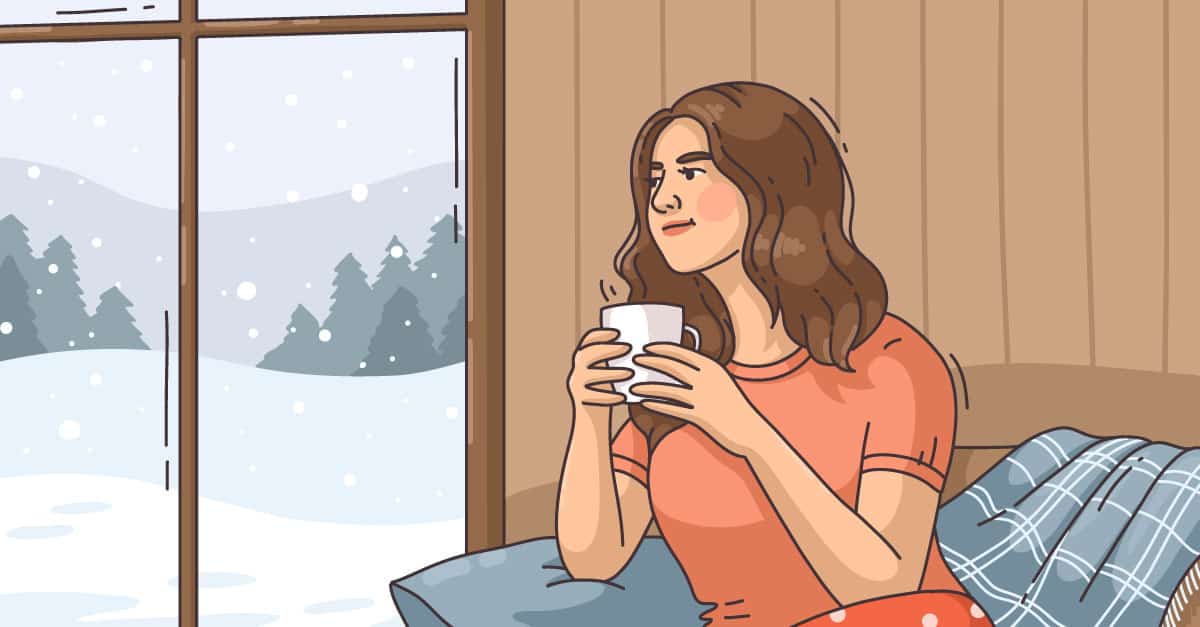Do you normally have a sunny disposition, but the winter blues are keeping you down? The long, cold, dark days that accompany the winter months can affect your mood, circadian rhythm, and energy levels. Some people may even develop a seasonal form of depression known as seasonal affective disorder (SAD). Keep reading to learn why you may be feeling a dip in your mood and how you can lift it.
Why Do I Have the Winter Blues?
During winter, the Earth’s axis tips us away from the sun, leading to shorter, colder days. This means you’re probably spending less time outdoors and getting less sunlight than normal. Your body’s internal clock or circadian rhythm relies on light to let you know when it’s time to wake up and fall asleep. Specifically, your brain makes the hormone melatonin to control the sleep-wake cycle. Without enough light, you’ll keep making melatonin during the day — which affects your mood and energy levels.
Seasonal Affective Disorder (SAD)
Sometimes, the winter blues are more than just feeling “low” or lacking energy. SAD is a form of major depressive disorder that affects people during the fall and winter months. According to the American Psychiatry Association, around 5 percent of the American population experiences SAD every year.
The symptoms of SAD are different from the occasional bad day or week. SAD can make you feel extremely depressed or sad to the point where your mood interferes with your daily activities. Other symptoms include:
- Increased fatigue (mental and physical exhaustion) or energy loss, even if you’re getting enough sleep at night
- Changes in your sleep patterns, like sleeping too much
- Feelings of hopelessness, worthlessness, or guilt
- Having trouble thinking, making decisions, or concentrating
- Loss of interest in activities or hobbies you usually enjoy
- Thoughts of suicide or death
If you think you may have SAD, it’s important to talk to your doctor. They’ll prescribe some of the same treatments used for depression, like antidepressants and talk therapy. You can also follow some of the tips below to help lift your mood in addition to your prescribed treatments. Fortunately, SAD symptoms tend to get better as the seasons change.
8 Ways To Lift Your Mood in the Winter
1. Get Some Extra Sunlight
It may not sound fun during cold weather, but stepping outside for a walk gives you extra sunlight to boost your mood. You’ll also get some fresh air at the same time! If you can’t make it outside, sitting by the window on a bright day also does the trick.
2. Try At-Home Light Therapy
Doctors also prescribe light therapy to treat winter blues and SAD. If you’re interested in trying this technique, look for a light box that emits 10,000 lux of light intensity. Experts recommend sitting in front of the light for 30 minutes right after you wake up.
3. Take on a New Winter Hobby
Winter is the perfect time to take up a new sport like downhill or cross-country skiing, snowboarding, or ice skating. Ask friends or family to come along for some company. Winter sports are also a great way to get outside for extra sunlight — but be sure to bring your sunscreen!
4. Keep a Regular Sleep Schedule
It’s hard not to crawl into bed when the sun sets at 4:30 pm, but an early night can disrupt your body’s circadian rhythm. Try to fall asleep and wake up around the same time every day. Sticking to a regular schedule can help improve your energy levels and mood.
5. Fuel Your Mood with Food
SAD may make you crave foods high in carbohydrates, like bread, pasta, sweets, and sodas. This can result in overeating and weight gain. Experts recommend balancing your diet with nutritious foods to give your body the fuel it needs. Try adding a side salad to your pasta dinner or a piece of fruit with your morning pancakes.
6. Try an At-Home Workout
Don’t feel like leaving your house for the gym? Try working out at home with guided exercises on YouTube or from DVDs. Exercising 3 times a week has been shown to help treat depression.
7. Make Your Home Cozier
Staying cooped up indoors on cold winter days can put a damper on your mood. Consider picking up a few extra items to cozy up with — like a warm blanket and candles. The more comfort you find in your surroundings, the better your mood may be.
8. Give Your Time to Others
The holidays are a great time to volunteer and give some of your day to others in need. Look for a local organization you’re passionate about and volunteer as often as you’d like. You’ll benefit from social interaction, getting out of the house, and knowing you’re helping others.

